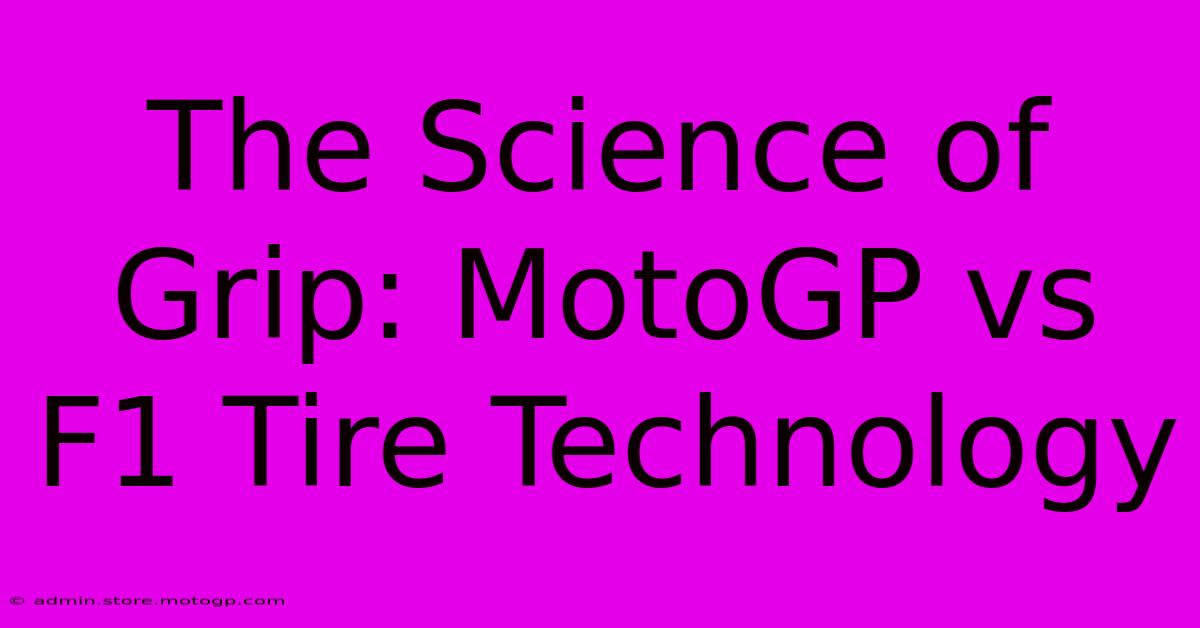The Science Of Grip: MotoGP Vs F1 Tire Technology

Table of Contents
The Science of Grip: MotoGP vs F1 Tire Technology
The roar of the engines, the screech of tires, the breathtaking speed—Formula 1 and MotoGP are pinnacles of motorsport, each pushing the boundaries of engineering and performance. While both rely on exceptional tire grip for speed and control, the science behind their tire technology differs significantly due to the contrasting nature of the vehicles and racing surfaces. This article delves into the fascinating world of tire technology, comparing and contrasting the approaches taken by MotoGP and F1.
The Fundamental Differences: Bikes vs. Cars
The most significant difference lies in the contact patch. MotoGP bikes utilize a much smaller contact patch compared to F1 cars. This translates to an incredibly high pressure concentration on the tire, demanding exceptional grip and requiring a unique tire construction to withstand the extreme forces. F1 cars, with their wider tires and significantly greater weight distribution, possess a larger contact area, distributing the forces more evenly.
Tire Construction: A Tale of Two Designs
MotoGP tires are designed for extreme lean angles, often exceeding 60 degrees. This necessitates a highly flexible sidewall construction that allows for significant deformation during cornering. The tire compounds are meticulously engineered to provide maximum grip at these extreme angles, often sacrificing some straight-line stability.
F1 tires, while also requiring high grip, prioritize different characteristics. They need to withstand massive lateral and longitudinal forces during high-speed cornering and acceleration/braking. Their construction focuses on stiffness and structural integrity to maintain consistent performance under these extreme loads. The compounds are often tailored for optimal performance across a broader range of operating temperatures and conditions.
Compounding the Challenge: Material Science and Performance
Both MotoGP and F1 employ sophisticated tire compounds, incorporating various materials to optimize performance. Silica is a key ingredient in both, enhancing grip, particularly in wet conditions. However, the specific formulations and proportions vary considerably.
MotoGP often utilizes more specialized compounds, focusing on maximizing grip at the edge of the tire during lean angles. This necessitates a more complex rubber matrix and potential inclusion of other additives to achieve the desired characteristics.
F1 compounds are designed for a broader operational window, emphasizing consistency and durability over a wider range of temperatures and track conditions. This approach prioritizes predictability and consistency over potentially higher peak grip.
Tread Patterns: Grip and Water Management
The tread patterns on MotoGP and F1 tires are distinctly different. MotoGP tires often feature a smoother, less aggressive tread pattern, allowing for maximum contact with the surface, crucial for maximizing grip at high lean angles.
F1 tires incorporate more aggressive tread patterns, especially in wet conditions. These patterns effectively channel water away from the contact patch, improving grip and preventing aquaplaning. The tread design also plays a crucial role in managing tire temperature and wear.
The Impact of Track Conditions: Adaptability is Key
Both MotoGP and F1 tires need to adapt to varying track conditions. However, the adaptability requirements differ. MotoGP tires often need to perform well across a wider range of track surfaces and temperatures. This demands sophisticated compound engineering and design.
F1 tires are often more specialized, with teams meticulously selecting compounds based on the specific characteristics of each race track. The teams also fine-tune tire pressures and strategies to extract maximum performance in various conditions.
Conclusion: A Balancing Act
Ultimately, the science of grip in MotoGP and F1 boils down to a delicate balancing act. Both disciplines strive for maximum grip, but the specific demands of the vehicles, racing surfaces, and conditions necessitate different approaches to tire technology. Understanding these differences provides a deeper appreciation for the engineering marvel that is high-performance tire technology in these two thrilling racing series. The continuous evolution of tire technology in both MotoGP and F1 reflects the relentless pursuit of speed, control, and ultimate performance.

Thank you for visiting our website wich cover about The Science Of Grip: MotoGP Vs F1 Tire Technology. We hope the information provided has been useful to you. Feel free to contact us if you have any questions or need further assistance. See you next time and dont miss to bookmark.
Featured Posts
-
Moto Gps Most Respected Riders Leading By Example
Feb 19, 2025
-
Dominate Your Moto Gp Sprint Fantasy League
Feb 19, 2025
-
Cota Open Track Days The Perfect Birthday Gift
Feb 19, 2025
-
The Evolution Of The Formula One Starting Grid
Feb 19, 2025
-
The Thrill Of Cota General Admission Access
Feb 19, 2025
